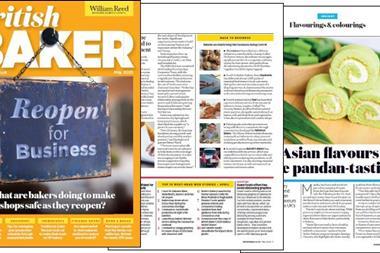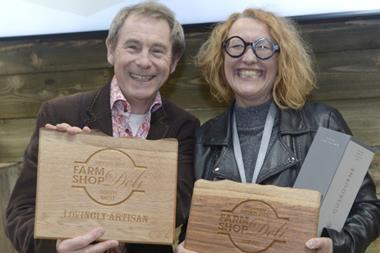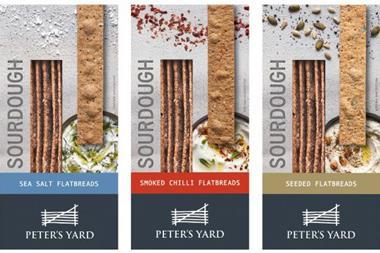Nick Sandler has an enviable job. Without having to stress about the day-to-day hassles of running a business, Nick’s remit is to be ‘creative’. In fact, it is in his job title: ‘creative chef’ for sandwich chain Pret A Manger. This means working in the kitchen all day developing original ideas using new and interesting ingredients. Lucky for some.
“Our food meetings are great fun, they really are,” he says, clearly delighting in the role, which he took up at the end of 2004. “It’s the high point of my week and I’m working up to it the whole time, trying to think of how to sell ideas to the other members of the team.”
Whereas some companies are happy to trust their faithful old recipes and customer favourites to steer their business, Pret displays an almost obsessive-compulsive compunction to tinker with its products.
In the first three weeks of January alone it made 28 changes to its products. These ranged from small changes in seasoning to replacing lines with new products, to introducing four own-label drinks.
Creating novel yet commercial products with strong branding and company ethics – including clean labels, eco-friendly packaging and left-overs distributed among homelessness charities – has seen the company carve out a niche for itself in the high street sandwich trade, not to mention a loyal customer base.
National presence
Pret was established as a one-off shop by university friends Julian Metcalfe and Sinclair Beecham in Victoria, London, in 1986. The chain, which now has a strong grip on the capital, has since branched out nationally. It now has 150 outlets in places such as Brighton, Manchester, Birmingham, York, Leeds, Glasgow and Edinburgh, as well as stores in New York and Hong Kong.
Today, Pret turns over around £150m a year. In 2001 McDonald’s bought a 33% stake for £50m.
Pret constantly reviews its use of ingredients and holds twice-weekly food meetings where Mr Sandler, the food team and Julian Metcalfe, now creative director, thrash out their latest ideas.
One new ingredient that Pret is pioneering is a mayonnaise replacement for sandwiches and salads derived from a Lebanese recipe that uses labna – a thick yoghurt.
Branded Yummy Yoghurt, it is still relatively high in fat, but contains less than mayonnaise. With a distinctive creamy flavour and slight tang, its healthy bacteria content also appeals to consumers with a probiotic bent.
Food manager Ian Watson co-ordinates the whole team, and Nick works closely with development chef Richard Edney, making as many different salad and sandwich combinations as possible until they hit upon the jackpot. “If we’ve got a new roasted tomato in, we’ll try to use it in every possible way,” says Nick.
The technical department tests all new sandwich creations for shelf-life, weights and measurements. The sandwiches are made fresh daily and are not stored overnight. An eight-hour shelf-life means the avocado cannot turn brown, the bread should not become soggy and the product must retain its visual appeal for the duration of its time on-shelf.
The department will also check the salt content. Pret has taken a responsible approach to salt by reducing the amount in all of its key products. But Mr Sandler explains that salt is not the be-all and end-all of flavouring a product.
“The thing about salt is that consumers can’t take it out, but they can add it if they want to,” he reasons. “We always look at getting other flavours into our sandwiches, such as lemon juice, or more pepper, or more spices. We’re always looking at ‘ethnic’ ingredients, whether it is a harissa (chilli) paste from Morocco or a rendang curry paste from Malaysia. We will never shy away from using these sorts of flavours.”
Fishing for ideas
Subtler changes to existing flavours can equally pay off. Pret recently tweaked its traditionally smoked salmon by leaving on the skin that forms during smoking (called the pellicle) for a more immediate, powerful smoky flavour. Previously the subtlety of the smokiness was lost amid the other ingredients, says Mr Sandler.
The choice of bread is also important for the balance of a sandwich. Careful thought goes into getting the blend between breads and fillings right, he says. “For example, when you think of chorizo or cured meats, you think baguettes. The flavours in a wholegrain bread would be too strong. So we’re always thinking about combinations.”
In recent times, the company switched bread supplier from one of the big three plant bakers to a smaller scale producer – Fosters Bakery, based in Barnsley, South Yorkshire. And when sandwiches are your stock in trade it is worth getting the bread right.
Mr Sandler says he has high hopes for Pret’s Artisan Baguette, trialled in selected shops in January, with a ham, egg and Italian cheese filling for £2.70. This is the latest addition to its range of 15 baguettes, 80,000 of which are sold every week.
“It’s a French bread with a bit of sourdough in it – a multi-cereal, as they call it. We hope to give it wider distribution.”
The recipe was devised by French catering company Le Notre and is made by French bakery Bridor based in Brittany partly from levain, with a slow fermentation process. It is hand-finished and part-baked in a stone oven, and baked-off in-store.
Slim pickings
The company is also prepared to try out new formats, such as its Slim Pret single sandwiches, which have been successful despite initial doubts.“Are people downgrading from a normal sandwich or are they upgrading from a soup?” he speculates.
“How do you assess whether they are taking away from another part of the business or adding to the business as a whole? These are the questions we have to ask ourselves. But I would say it has been a success because so many people are talking about it.” He adds that the firm is set to continue with the format.
In all, Pret sells 29 sandwiches, three wraps as well as the baguettes. Classic Tuna, Super Club and All Day Breakfast are three of its mainstays, but many niche products are assured of their places on the shelves too, he says. “There are some products that sell a bit less, but we have core customers that absolutely love them.”
Pret’s pecan pie – an old favourite – is a case in point. By no means a best-seller, the risk of a backlash from Pret’s vocal customers meant a move to replace it was shelved. “Julian called up and said, ‘We cannot take this off the shelf!’” he recalls.
Some recent cake products have been devised by Mr Sandler, but others are developed with Pret’s suppliers, such as the mixed berry doughnut. This is baked rather than fried for a lower calorie content (165 kcal) and sells for 60p. Meanwhile, pastries are sourced from outside suppliers and baked-off in-store.
He says Pret is increasingly looking to use meal names with its products, such as a Mushroom Risotto soup. The one-time sandwich-only retailer will be offering a broader range of soups in the coming months. An improved range has already seen sales of soups increase from 1% to over 5% of total sales in a good week. One of the reasons, apart from landing some fantastic recipes, he says, was finding a method of serving large volumes of soup easily.
“We heat up a lot of soup, put it in cups, and keep them in a hot cupboard. The last thing you want to be doing is ladling out soup at lunchtime.”
It also uses this system for a range of hot wraps. The wraps are assembled, wrapped in brown paper, put in the oven for 15 minutes and then kept in a hot cabinet for up to two hours.
Future horizons
Kitchen staff make up most of the products daily in the in-store kitchens and the ease with which a product can be assembled informs NPD. And there is, of course, one big limit to innovation: the customer. “I don’t think we’d ever remove mayonnaise from the business completely,” he says. “There’d be a national outcry!”
So what’s next on the horizon? “We’re looking at introducing more complex carbohydrates into the food with lots of colour,” he reveals. “We’re looking at more ethnic foods, mainly Mediterranean, where a lot of the healthy foods come from, like olive oils, fresh herbs, yoghurts, chickpeas and lentils.”
Pret’s main focus will still be to continually upgrade its ingredient, he adds. There is even a rallying call for small ingredients suppliers to get in touch via its website.
Also published online for bakers seeking sandwich inspiration is a full list of the company’s recipes. Meanwhile a Pret A Manger recipe book is in development.
Finally, what is the single best tip he could offer a baker looking to revamp their sandwiches? “Julian Metcalfe has this classic comment – he’ll look at a sandwich, shake his head and say ‘too brown’. That’s one of my major defining factors when creating new sandwiches!”
Nick Sandler
Co-founder of SoupWorks, which specialised in selling hot soup from retail units, Nick has been creative chef at Pret A Manger since late 2004. He previously worked as a development chef for companies such as Duchy Originals, Joubere and others, and has written three books: Soup, Mushroom, and Preserved. He is presently compiling The Duchy Originals Cookbook, due to be published in September.


























No comments yet